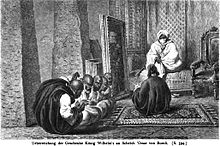| Umar of Borno | |
|---|---|
| Shehu of Bornu | |
 "Umar von Bornu" on 6 June 1870 by
Gustav Nachtigal in his travel's narrative,
Sahara und Sudan, p.594 | |
| Reign | 8 June 1837 - 4 October 1853 (deposed by coup) |
| Predecessor | Muhammad al-Amin al-Kanemi, Kanemi |
| Successor | Abd ar-Rahman ibn Muhammad al-Amin |
| Reign | 3 September 1854 - December 1881 |
| Predecessor | Abd ar-Rahman ibn Muhammad al-Amin |
| Successor | Bukar Kura |
| Born | Umar I ibn Muhammad al-Amin |
| Died | December 1881 Borno |
| Burial | |
| Issue |
Bukar Kura Abba Ibrahim Hashim |
| Dynasty | Kanemi |
| Father | Muhammad al-Amin al-Kanemi |
| Religion | Muslim |
Umar I ibn Muhammad al-Amin ( Arabic: عمر الأول ابن محمد الأمين) or Umar of Borno (died 1881) was Shehu (Sheik) of the Kanem-Bornu Empire and son of Muhammad al-Amin al-Kanemi.
Reign of Umar
Umar came to power at the death of his father in 1837. [1] [2] Umar did not match his father's vitality and gradually allowed the kingdom to be ruled by advisers ( wazirs). Umar ruled from 1837 until November 1853 when he was deposed by his brother `Abd ar-Rahman ibn Muhammad al-Amin who became Shehu. The latter only reigned until 1854 when Umar reconquered his throne. [3]
Umar ruled as Shehu for a second time from September 1854 to 1880. Borno began to decline, as a result of administrative disorganization, regional particularism, and attacks by the militant Ouaddai Empire to the east. The decline continued under Umar's sons, and in 1894 Rabih az-Zubayr, leading an invading army from eastern Sudan, conquered Borno. [4]
Dynasty
Footnotes
- ^ Louis Brenner, The Shehus of Kukawa: A History of the Al-Kanemi Dynasty of Bornu, Oxford Studies in African Affairs (Oxford, Clarendon Press, 1973), p.72.
- ^ Herbert Richmond Palmer, The Bornu Sahara and Sudan (London: John Murray, 1936), p. 269.
- ^ Louis Brenner, The Shehus of Kukawa: A History of the Al-Kanemi Dynasty of Bornu, Oxford Studies in African Affairs (Oxford, Clarendon Press, 1973), pp.78-79.
- ^ Helmolt, Hans F., ed. (1903). The history of the world; a survey of a man's record, Volume III: West Asia and Africa. New York: Dodd, Meade and Company. p. 538. OCLC 1193060.
Bibliography
- Brenner, Louis, The Shehus of Kukawa: A History of the Al-Kanemi Dynasty of Bornu, Oxford Studies in African Affairs (Oxford, Clarendon Press, 1973).
- Cohen, Ronald, The Kanuri of Bornu, Case Studies in Cultural Anthropology (New York: Holt, 1967).
- Denham, Dixon and Captain Clapperton and the Late Doctor Oudney, Narrative of Travels and Discoveries in Northern and Central Africa, (Boston: Cummings, Hilliards and Co., 1826).
- Isichei, Elizabeth, A History of African Societies to 1870 (Cambridge: Cambridge University Press, 1997), pp. 318–320, ISBN 0-521-45599-5.
- Lange, Dierk, 'The kingdoms and peoples of Chad', in General history of Africa, ed. by Djibril Tamsir Niane, IV (London: Unesco, Heinemann, 1984), pp. 238–265.
- Last, Murray, ‘Le Califat De Sokoto Et Borno’, in Histoire Generale De l'Afrique, Rev. ed. (Paris: Presence Africaine, 1986), pp. 599–646.
- Lavers, John, "The Al- Kanimiyyin Shehus: a Working Chronology" in Berichte des Sonderforschungsbereichs, 268, Bd. 2, Frankfurt a. M. 1993: 179-186.
- Oliver, Roland & Anthony Atmore (2005). Africa Since 1800, Fifth Edition. Cambridge: Cambridge University Press. ISBN 0-521-83615-8.
- Palmer, Herbert Richmond, The Bornu Sahara and Sudan (London: John Murray, 1936).
- Taher, Mohamed (1997). Encyclopedic Survey of Islamic Dynasties A Continuing Series. New Delhi: Anmol Publications PVT. LTD. ISBN 81-261-0403-1.